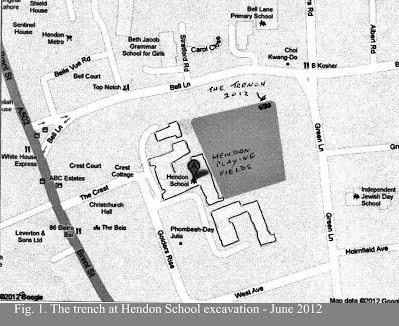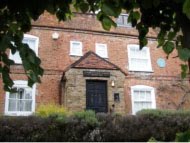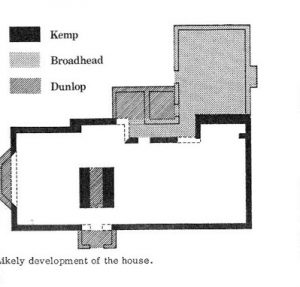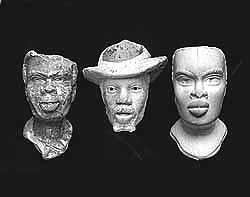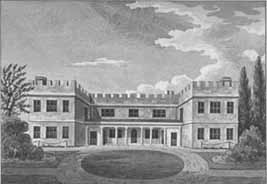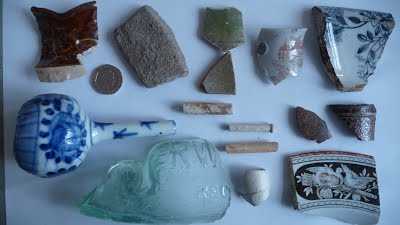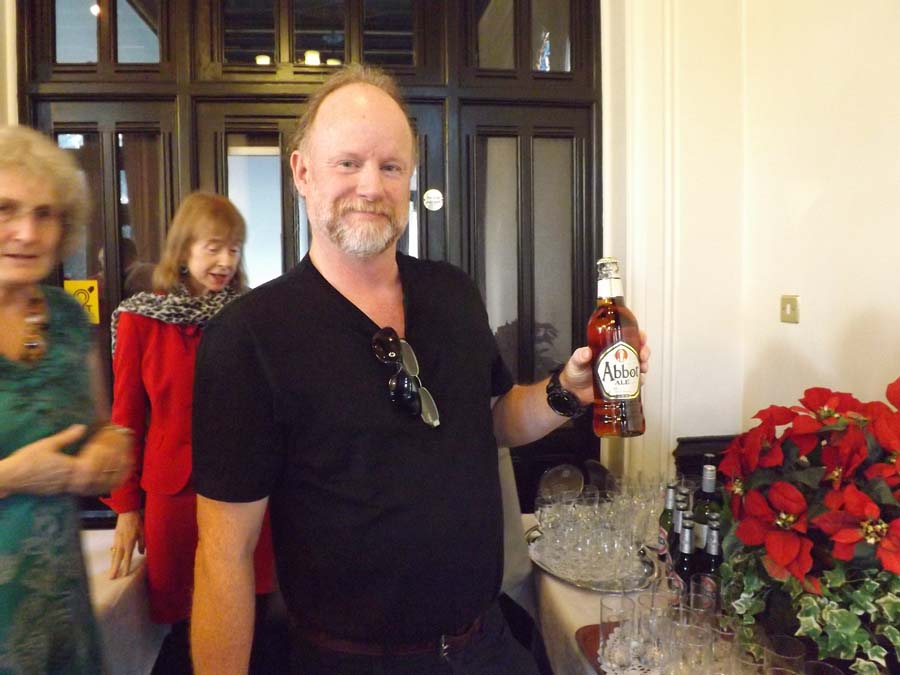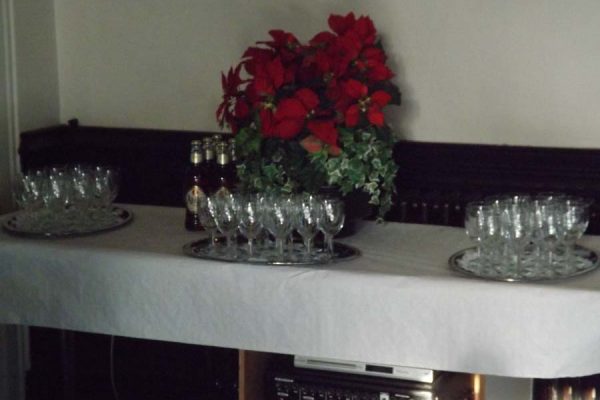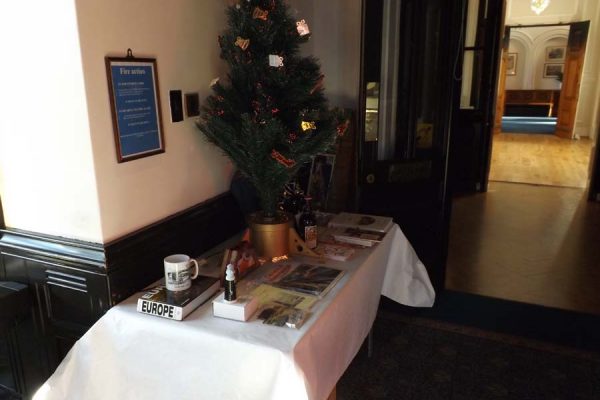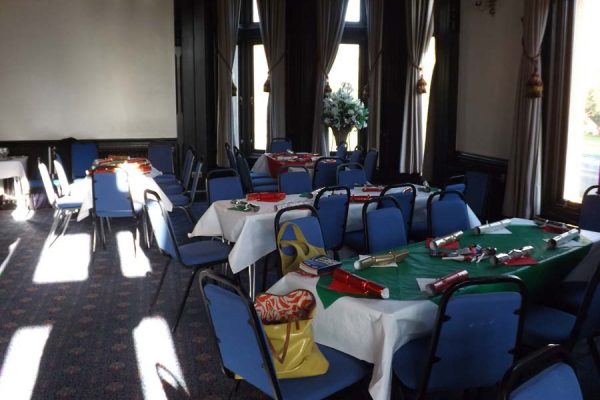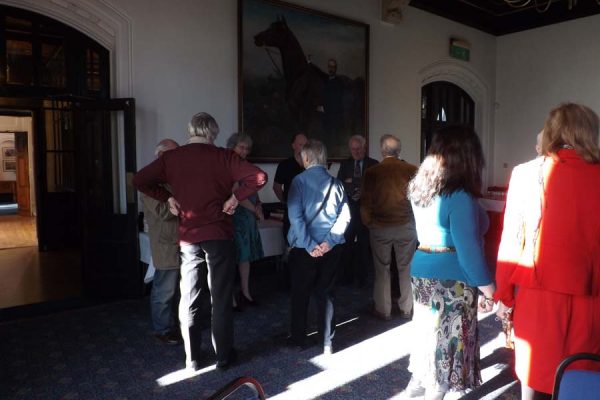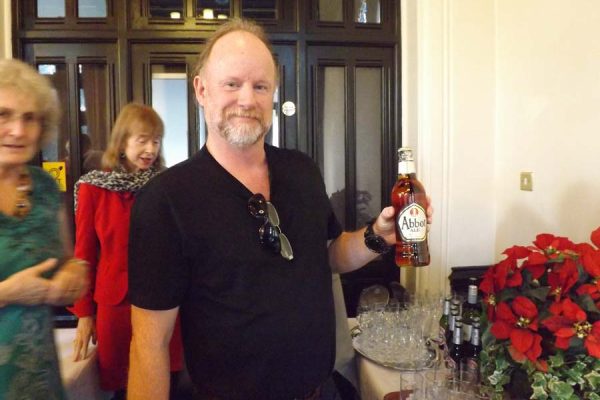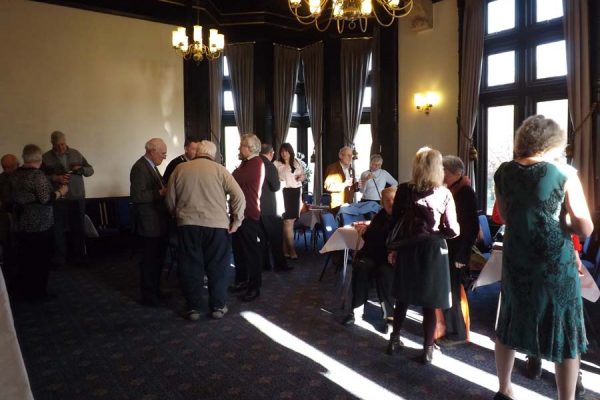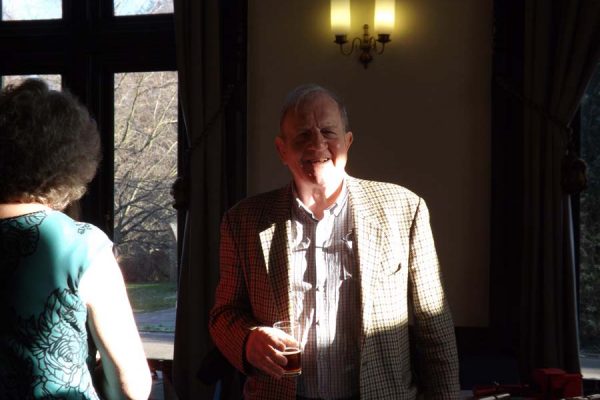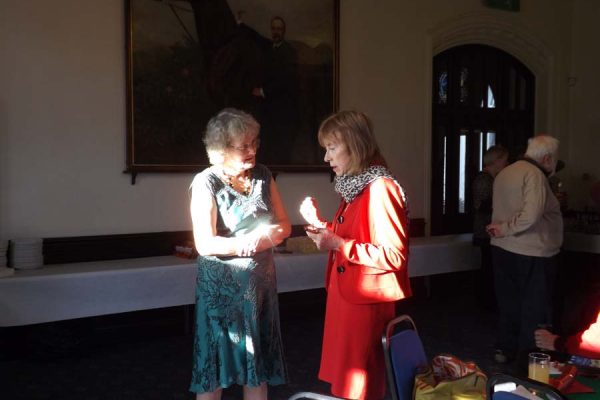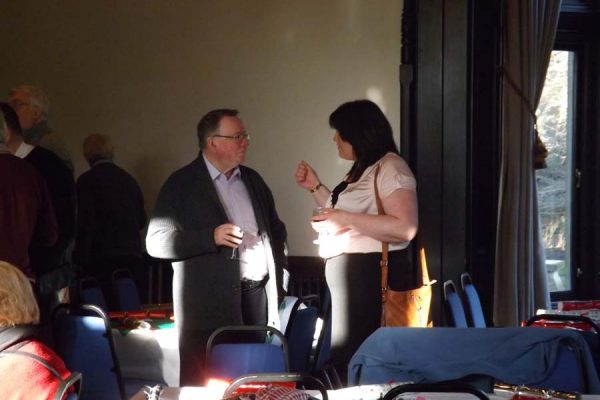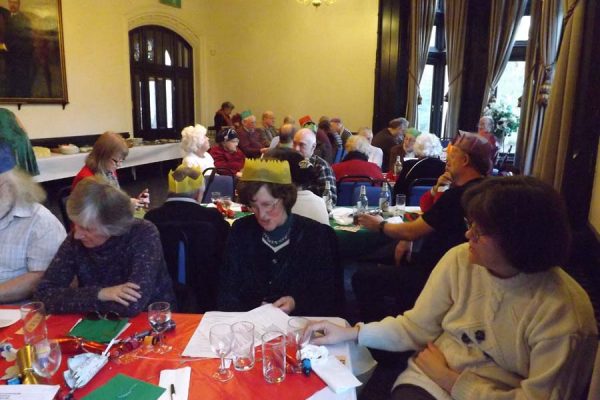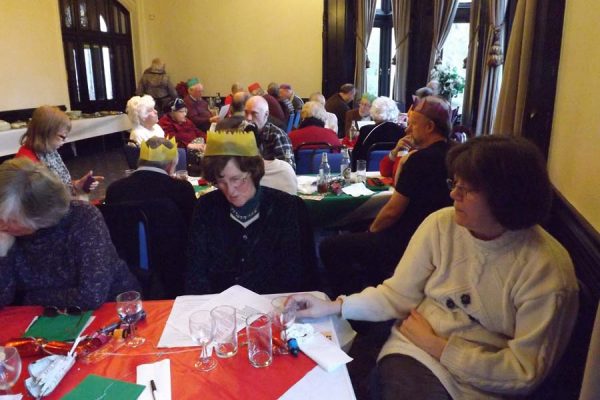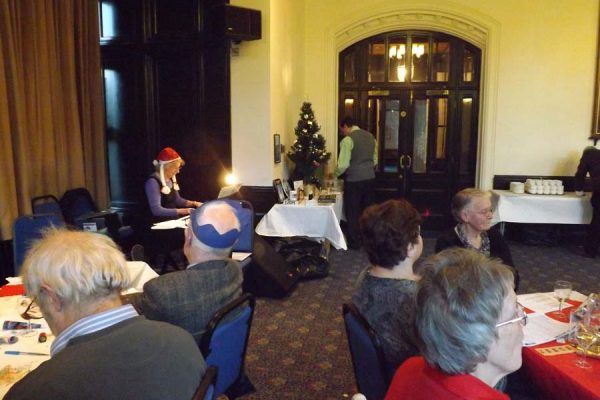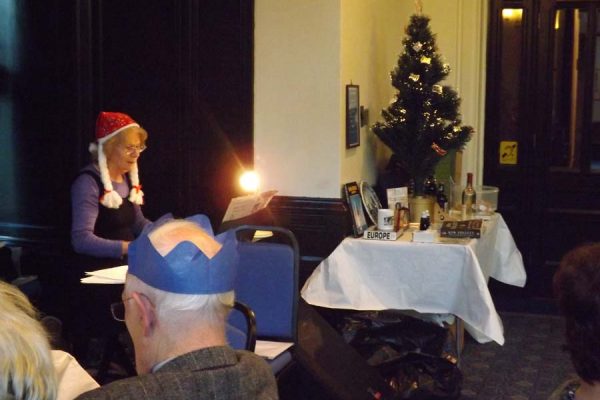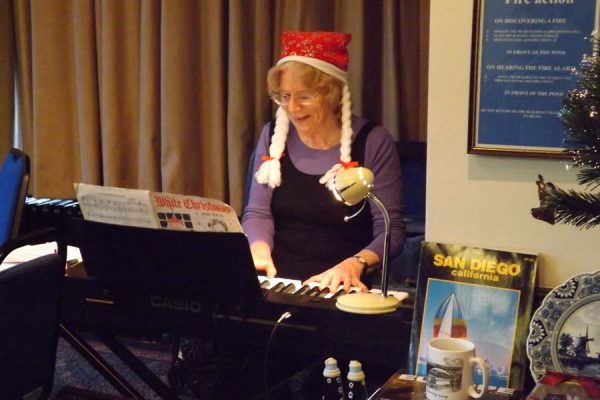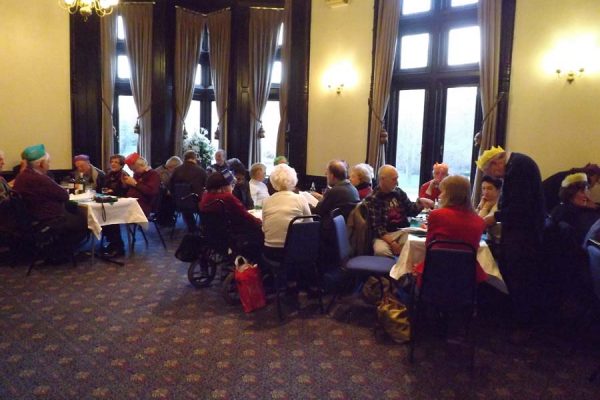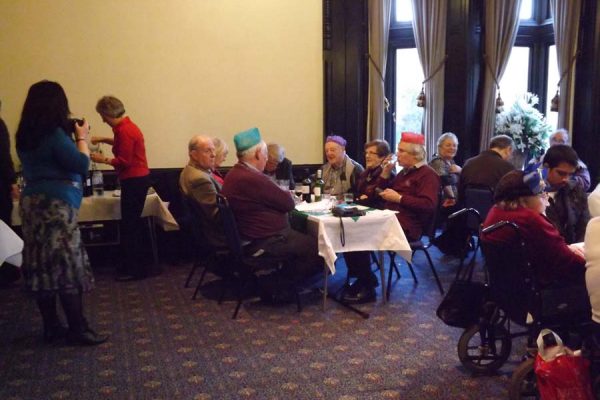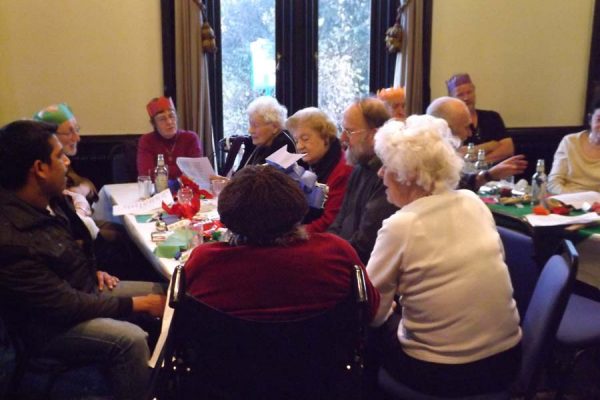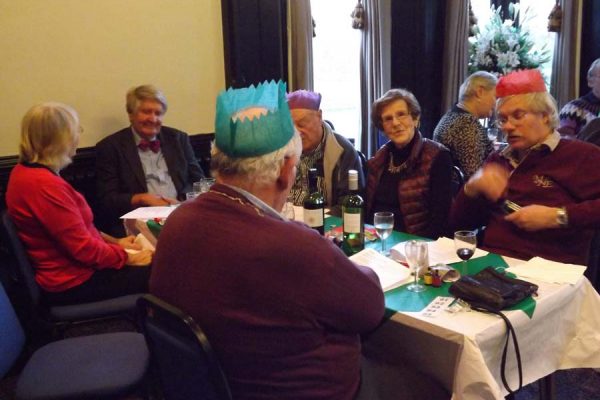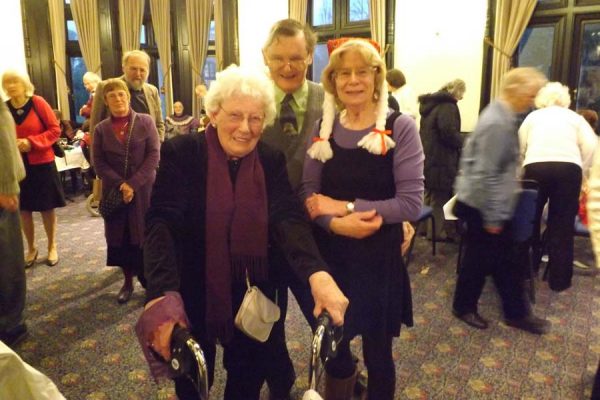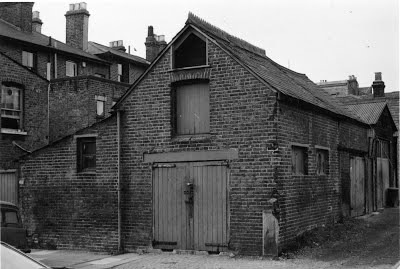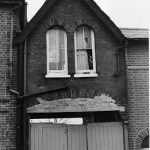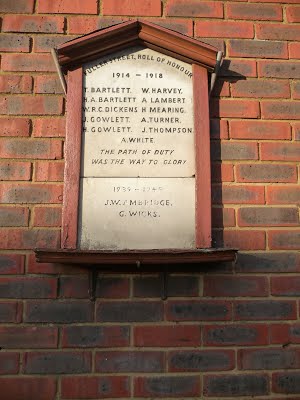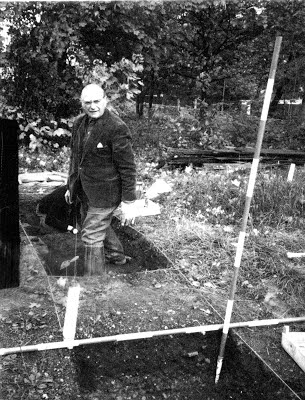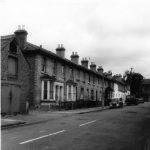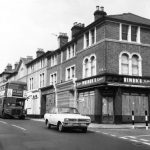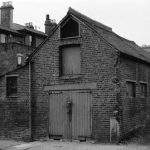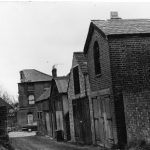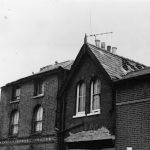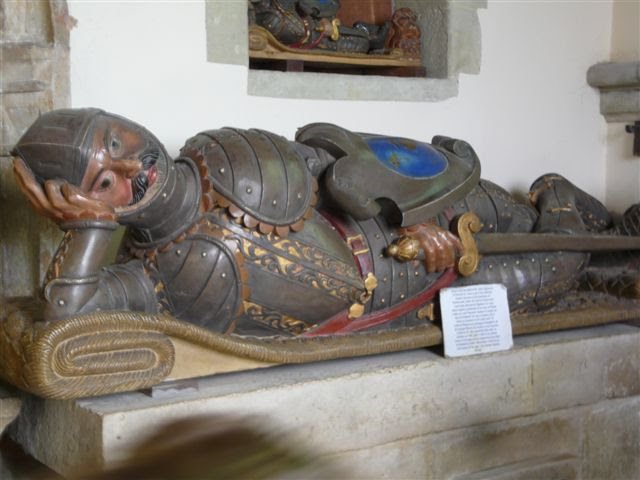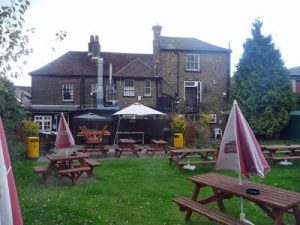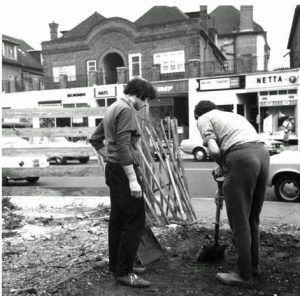No. 499 OCTOBER 2012 Edited by Stephen Brunning
HADAS DIARY 2012-2013
Tuesday 9 October: The Life and Legacy of George Peabody – Lecture by Christine Wagg.
This first talk of the new lecture season will outline the life and work of George Peabody, an American merchant banker and philanthropist. He founded the Peabody Trust in 1862 to “ameliorate the conditions of the poor and needy of London”. His trustees were given a total of £500,000 to build affordable housing for working-class Londoners. “Peabody Buildings” remain a feature of London’s landscape to this day. Since the last war the Trust has acquired properties from a number of other organisations which pioneered the development of working-class housing, including The Society for Improving the Condition of the Labouring Classes, and the Improved Industrial Dwellings Company.
The Trust now owns or manages approximately 20,000 dwellings and is London’s largest charitable housing association. The talk incorporates an account of the history of the Trust and describes some of its older properties, as well as a few highlights of its archive collection.
Christine Wagg works as legal assistant to the Peabody Trust. In 1994 she was responsible for arranging the transfer of the Trust’s archive collection to London Metropolitan Archives in Clerkenwell and she regularly deals with enquiries about the Trust’s history and early records.
Tuesday 13 November: Archaeological Discoveries in Southwark – Lecture by Peter Moore, Pre-Construct Archaeology.
Sunday 2 December: Christmas Party at Avenue House, 12 noon – 4.30 pm (approx.) A buffet lunch. Price £22 to include some drink. Booking form in next month’s newsletter.
Tuesday 8 January: The Reign of Akhenaten: Revolution or Evolution? Lecture by Nathalie Andrews.
Tuesday 12 February: From Longboat to Warrior: the evolution of the wooden ship. Lecture by Eliott Wragg, Thames Discovery Programme.
Tuesday 12 March: The Railway Heritage Trust – Lecture by Andy Savage.
Tuesday 9th April: Nautical Archaeology – past, present and future – Lecture by Mark Beattie-Edwards – Programme Director, Nautical Archaeology Society.
All Lectures are held at Avenue House, 17 East End Road, Finchley, N3 3QE, and start promptly at 8.00 pm, with coffee /tea and biscuits afterwards. Non-members welcome (£1.00). Buses 82, 125, 143, 326 & 460 pass nearby and Finchley Central Station (Northern line) is a short walk away.
JUNE PORGES: 1929-2012
Jean Bayne writes:
June died peacefully on Thursday September 6 in University College Hospital with her family around her. She had been coping bravely with cancer for some time.
Born in 1929 in Cheshire, June spent her early years in the North and later, during the war years, attended a boarding school in North Wales. She loved Snowdonia and took her family back for many happy holidays there in later years. Trained as a librarian, she came down to London, where she met Hans, her future husband. After a short, whirlwind romance, they married in 1956 and settled in Hampstead. This was, without doubt, June’s favourite place in London! But the pressures of a growing family and the needs of elderly parents led to a move to Finchley in 1971. In the same year she joined HADAS.
During the seventies, she was very involved with the West Heath dig on Hampstead Heath, revelling in the opportunity to focus on ‘real’ archaeology while she studied for the Diploma. It was the first Mesolithic site to be discovered in Greater London. She enjoyed both the friendships she made and the excitement of the practical experience. Helping to organize training digs, at one point, she and Hans provided a tent for the training session so that students could work and rest under cover. Tessa Smith remembers her on a HADAS trip in 1984 to Ickworth where June and Hans saw a field of buttercups and could not resist sitting down in the middle of them and laughing together. Tessa also remembers June’s generosity in hosting a birthday party for George Ingrams (his 90th). The cake had a digging trowel to cut it!
June was always willing to become involved and worked proactively for HADAS over many years. She soon joined the committee and became the librarian/archivist for the society. In this role, she not only catalogued the books owned by HADAS but was also active in encouraging the use of the library by giving her time as an adviser to students.
For many years, June also undertook the responsibility of finding speakers for the monthly lectures and wining and dining them beforehand. She contributed to the Newsletter and was always interested in the Society’s general activities. Furthermore, with Stewart Wild, she arranged yearly outings to places of archaeological interest, determined to include an actual dig wherever possible. I feel that the St Albans trip this year will be a special time to remember her.
June developed her interest in mosaics by joining ASPROM, a society for the preservation of Roman mosaics and she was always delighted when we came across any mosaics on our trips. Her general interest in archaeology, history and culture underpinned extensive travelling around the world: this included Zimbabwe, India, Australia, Russia, the Middle East, New Zealand, Morocco, America, Italy and France, Colombia and Egypt.
Another passion was opera. June joined the Amici di Verdi Society and went to Italy each year to see operas. She also undertook an opera degree at Rose Bruford College when she retired, graduating in 2006. The course was very challenging as June had no initial musical training but she bought a keyboard and found some help. The students were all opera buffs and, I think, they so enjoyed their course with opera visits, opera weekends and lunches that they took the modules quite slowly so they did not have to finish the course too quickly! A devotee of the English National Opera, June almost became a fixture there. She went several times a week, seeing dress rehearsals as well as final performances, and also helped out as a ‘Friend’. Her son Adam felt she would not be able to bear the idea of no longer being able to go.
Another very strong interest was Russia, its history and culture. June attended lectures every year and read widely. A few years ago, June and I went to Russia, travelling by boat between St Petersburg and Moscow, and she impressed the guide very much with her wide-ranging knowledge. One of the highlights of the trip was meeting up with June’s grandson, Edward, who was studying in Moscow at the time. He took us around and was able to order food for us and explain aspects of day-to-day Russian life, such as travelling on the wonderful but confusing metro system.
June adored her large family and birthdays and landmark events were always accompanied by lunches at Kenwood or parties at home. Christmas was a very special time, celebrated on Christmas Eve according to Austrian custom (Hans was brought up in Austria). All the family gathered at June’s house. I was always enchanted by the real, lighted candles on the Christmas tree – a very important ritual!
It was also a time when she particularly missed Hans: he died in 1990 from Legionnaires’ disease. However, she continued, then, to work in her day job which may have helped a little. By that time, she had been well established for many years as Head of Information in the Exploration Department of British Gas. She brought her organizational and managerial qualities to whatever she did and HADAS benefited greatly. Chairing meetings and general committee work were second nature to June. But she was also very socially skilled, able to relate to many different types of people and she knew how to reconcile differences and move things ahead in a calm, positive way. She had warmth, charm and an intelligent perception about people laced with a very good sense of humour. Above all, she was strong, brave and independent with great leadership qualities: very much her own woman. I never heard her complain even when I knew she was suffering.
I had lunch with her just before the recent HADAS trip to Ironbridge. At that point, she was very breathless and becoming increasingly immobile. However, she was very animated, laughing and joking throughout the meal. She made it clear that she knew she was coming close to the end of her life and was able to accept it, saying that she had had a good life. I shall always treasure the memory of the last time I saw her because, by the time I returned from Ironbridge, she was in hospital, completely exhausted. In the event, the end came very suddenly: far too soon for all of us.
She leaves three children: Adam, Joanna and Simon and a stepdaughter Tessa, and their spouses Mariana, Warren, Alison and Ingolf. And seven grandchildren too: Edward, Johnny, Arron, Kerry, Emily, Daniel and Oliver.
On behalf of HADAS, I would like to send them all our condolences. June will be very much missed.
Stewart Wild adds:
June lived in Finchley, in a nearby road, even longer than I, and was my nearest HADAS neighbour, so to speak. When the weather was bad we would sometimes offer each other a lift to meetings at Avenue House. I hadn’t known her very long before she was sadly widowed.
We became good friends, for she was a lively conversationalist with an excellent memory, and I always enjoyed hearing about her adventures, from memories of boarding school in World War II and later librarianship to travels in Austria and elsewhere and her love of opera. In 2007 she joined me and a small group of friends on a wonderful three-week tour of India which included steam train experiences in Shimla and the famous Darjeeling Himalayan Railway.
In 2000 I visited the newly reopened Royal Gunpowder Mills at Waltham Abbey and was so impressed that I invited the director to speak to HADAS at our monthly meeting. When I suggested a day-trip to Waltham Abbey, including the old Temple Bar (at that time in a nearby field), June kindly agreed to help me with the arrangements, and the first of our HADAS summer outings took place in August 2001.
Since then we have jointly organized one each summer, covering a wide range of historic locations in southern England. June’s contribution was immense as she knew more about archaeology that I ever will, and as a committee member she kept me in touch with HADAS policy and contacts. For my part, June was happy to leave me to sort out transport, itinerary and costings.
This month’s outing to St Albans is our twelfth joint effort, and I am so sorry that it will now be our last. We shall all miss her sunny personality and vast knowledge.
Ironbridge – Jim Nelhams
A Golden Coach for an outing! No, not Cinderella, but our group of 32 heading for our extended outing in the Ironbridge area. For the third year running, we had Dave as our driver. He claimed he had tried to get out of it, but we had promised him some challenges to his driving skills.
Our first stop was for coffee at The Narrow Boat at Weedon. This watering hole is situated on the A5 just where it crosses the Grand Union Canal, and provides a terrace with a view of the narrowboats as they make their stately way along at a maximum four miles per hour.
Suitably refreshed, we continued along the A5 (alias Watling Street). Our next stop was at Wall, a site visited by HADAS on a trip some years ago. Our thanks to Terry Dawson for suggesting it. Thence we moved to Buildwas Abbey (not Bill Bass Abbey) before a five minute drive to our hotel. As the hotel itself has an interesting history and splendid decoration, it is included in our write-ups.
Roman Wall – Simon Williams
Today, Roman Wall is dominated by an 1837 church with an interesting steeple: more Picturesque than Neo-Gothic, by the young George Gilbert Scott (of Albert Memorial fame). The Roman name for Wall – Letocetum – is possibly a Romanization of an earlier Iron Age name meaning ‘grey wood’ (‘leto’, or ‘llwyd’ in Welsh, meaning grey, and ‘cetum’, or ‘coed’ in Welsh, meaning ‘wood’). Indeed, there is some evidence to suggest pre-Roman activity on the site.
The site of Roman Wall was an important posting station and staging post on Watling Street – the busy and vital route north – with accommodation in a guest house. Bath suite fragments of sumptuously painted mythological scenes are preserved in the museum and furnace stoke-holes are visible. This and the associated gym were twice extended. The guest house was used mainly by couriers on official business who would cover about 50 miles a day. Later a civilian settlement developed.
The site also comprises an early Marching Camp and forts of 60-110 AD – one built in response to the Boudiccan rebellion. On all the military sites at Wall army occupation was rapidly followed by civilian buildings and industrial activity: metal-working and, in particular, glass-working.
The small museum houses artefacts ranging from the general – an impressive part of a stone column and clay tiles with impressions of animal feet, including deer (which further illustrates a woodland setting, quite unlike the present-day) – to the personal, such as jewellery. Of particular note, a finger ring with the symbols of peace and plenty: clasped hands and crossed cornucopia, based on a coin reverse of 69AD.
Buildwas Abbey – Peter Pickering
“Bare ruin’d choirs, where late the sweet birds sang”, said Shakespeare in one of his Sonnets. Well, there was a sweet baby bird chirping in its nest high up in the chapterhouse of Buildwas Abbey. And though the choir was certainly ruined, a good deal of the fabric of this Cistercian Abbey by the Severn survived the dissolution of the monasteries. Built in the second half of the twelfth century, it was not altered very much over the next four hundred years. So, in the sunshine, it gave us a good impression of England in the Ages of Faith.
Buildwas was famous for its large number of books (many produced in the scriptorium on site); two recesses for cupboards to contain them are still there in a book room (armarium) opening off the cloister. There are, moreover, original tiles to be seen in various places, many collected together to form the centre of the floor of the chapterhouse; these tiles were a good introduction to the comprehensive display of Victorian tiles in the Jackfield Tile Museum which we visited later.
Best Western Valley Hotel – Frances Radford
The main part of the hotel was a house known as Severn House, built in 1757. It is now greatly extended taking in nearby buildings. The interior holds surprises such as a disused well in one hallway, two main staircases, a conference suite and among others, a couple of individual rooms with doors resembling front entrances to houses, one having two steps up. Someone said it makes you think there should be a bottle of milk on the top step!
A potted history
It was George Godwin, a Master Collier, who had the house built on the upper part of a meadow leading down to the Severn River. He died in 1773. It is known that around 1803 Sarah Darby bought it and having no direct descendants, bequeathed it to her niece Ann Dickinson in 1821. Bernard Dickinson, Ann’s husband, came from a Quaker family living in Beverley, Yorkshire. We do not know if they ever lived in Severn House, but a tythe map of Madeley 1849 states that their son Henry and his wife occupied the house. After Henry’s wife died, he married a Susannah Hadwen, daughter of a Liverpool banker, so by 1871, he was living in Liverpool and the new occupier of Severn House was Arthur Maw, aged 36.
John Hornby Maw, Arthur’s father, was keen to set up his sons in business and saw the possibility of making encaustic tiles in Worcester, but, after finding the clay there unsuitable, moved the whole workforce and equipment (a mammoth job) to Bentham near Ironbridge, where both coal and clay were readily available. A wise move, as at this time the demand had increased for floor tiles needed in the restoration of churches and civic buildings. As Maw’s factory output rapidly increased, other types of tiles were produced, e.g. hand painted and majolica, and exports ranged over many countries abroad.
Luckily the hotel has been able to retain the original majolica tiles on the walls of the old entrance hall and staircase, tiles which were specially made for the house. These were installed in 1890 by Robert Henry Clarke, an Ironbridge craftsman who worked for the Maws. The tiles are unique as the moulds used in their making were destroyed. Other tiles of interest lie under the carpet in the hotel entrance and there is also a fine tiled fireplace in room 18.
The next owner was Thomas Parker who proved to be something of an inventor. He was responsible for inventing the sparking plug, the electrification of tramways, an omnibus system, the Liverpool Overhead Railway and other structures. He also worked on a smokeless fuel – ‘Coalite’ – a product his son Thomas Parker junior further developed. The third Thomas Parker, a grandson, a celebrated forensic pathologist, lived for a short while in the house in 1908-9.
In 1939, Severn House was converted to a hotel by Wrekin Brewery. Changes followed with the present owners buying the hotel in 1988.
Early 19th century photographs show the garden of the house with tennis courts. One shows the terrace looking out beyond to the bank of trees on the far side of the river, much as it is today – a very beautiful setting.
HADAS organisers, Jim and Jo Nelhams, couldn’t have chosen better – a very pleasant and comfortable hotel providing delicious food. A BIG THANK YOU to them and the staff of the Valley Hotel.
Greetings to new members – Stephen Brunning
I would like to extend a very warm welcome to all the new members who have joined (or re-joined) HADAS since this time last year. They are: Adam Alim, Christopher and Juliette Brown, Tim Curtis, Julia Doherty, Simon Houlton, Clinton Hudgell, Audrey Joubert, Keith Martin, Jacqui Pearce, Joan Scannell and Kenneth Sutherland-Thomas. Look forward to seeing you at a forthcoming event.
Avenue House Appeal
Avenue House is important to HADAS. It is here that our archive and library are stored, with a lease of the garden room and garage. Our successful lecture programme and Wednesday evening course on post excavation analysis are held in the house.
The Grade II listed house and the ten acres of grounds were left to the people of Finchley in 1918 by Henry Charles Stephens, MP for Hornsey and son of the inventor of the famous Stephens’ ink. In 2002 the Avenue House Estate Trust (AHET) took over the running of the estate from Barnet Council.
At a crisis meeting in March 2011 it was reported that AHET had recorded losses of more than £30,000 and was in danger of being declared bankrupt in a few weeks. If this happened the house and gardens would be handed back to Barnet Council and conceivably be put up for sale, as befell the adjacent Hertford Lodge.
The Friends of Avenue House (FoAH) were re-formed in the spring of 2011 to raise funds which has helped the estate to survive the immediate financial crisis. Things are steadily improving, room bookings are up and donations/events last year have raised £19,000. However, it has been estimated the estate needs £80,000 per annum to cover the grounds maintenance costs alone. Can you help?
FoAH raises £12,000 per year by standing orders from neighbours and others interested in keeping the house and grounds open for all to enjoy. The majority pay £10 per month although a few donate up to £50 per month. Any help you can give would be gratefully appreciated. If you cannot contribute a regular amount, a single donation will enable the trust to carry out one-off repairs or help build up its reserves.
Please see the enclosed flyer or visit www.friendsofavenuehouse.org and click on “get involved” at the top of the page. Alternatively, email AHET Chairman Andy Savage at chairman@avenuehouse.org.uk.
Thank you.
Other Societies’ events, compiled by Eric Morgan
Wednesday 10th October 2.30-4pm. Mill Hill Historical Society. Trinity Church, The Broadway NW7 (please note new venue). The Brunels and their Tunnels. Talk by Robert Hulse.
Saturday 10th November 10.30am-4.30pm. Geologists’ Association Festival of Geology. University College, Gower Street, London WC1E 6BT. Exhibitions, fossil and mineral displays, stonecraft, books, maps, geological equipment and talks. Further details telephone 020 7434 9298. Visit www.geologistsassociation.org.uk. Admission FREE. Amateur Geological Society have a stand here.
Sunday 11th November 10.30am. G.A. Festival of Geology. London Building Stones Walk. Led by Eric Robinson (who once gave HADAS a talk on the building stones of our churches). Meet at the south (Green Park) entrance to Green Park station. Walk along Piccadilly to Hyde Park Corner. Lasts around 1.5 hours. Charge £5. Register by email fieldtrips@geologistsassociation.org.uk or telephone 020 7434 9298.
Wednesday 14th November 2.30-4pm. Trinity Church, The Broadway NW7. Grahame White and the London Aerodrome. Talk by David Keen.
Thursday 15th November 8pm. Enfield Society. Jubilee Hall, 2 Parsonage Lane/junction of Chase Side, Enfield EN2 0AJ. The History of Enfield’s Railways. Part 2: Western Enfield. Talk by Dave Cockle.
Friday 16th November 8pm. Enfield Archaeological Society. Jubilee Hall, 2 Parsonage Lane/junction of Chase Side, Enfield EN2 0AJ. Vice-Presidential Address. Jon Cotton. Visitors £1.
Saturday 17th November 10am-5pm. LAMAS Local History Conference. Weston Theatre, Museum of London. A Capital Way to Go: Death in London through the ages. (details in September newsletter).
Wednesday 21st November 8pm. Barnet Museum & Local History Society. Church House, Wood Street (opposite museum). AGM.
Saturday 24th November 10.15am-3.30pm. Amateur Geological Society’s Mineral & Fossil Bazaar. St Mary’s Hall, Hendon Lane N3. Rocks, crystals, gemstones, jewellery. Refreshments. Admission £1.
Wednesday 28th November 7.45pm. Friern Barnet & District Local History Society. St John’s Church Hall (next to Whetstone Police Station), Friern Barnet Lane, N20. London’s Transport 1900-1990. Talk by David Clark. Visitors £2. Refreshments 7.45pm and after.
Thursday 29th November 8pm. Finchley Society, Drawing Room, Avenue House. Dickens in the Outer Suburbs. Jean Scott Memorial Lecture given by Andrew Sanders. Non-members £2.

